Engineering Ambassadors Instills a Love of Communicating About Engineering—Both Inside of the Classroom and Out
“I think that I'm just a combination of the people that I know. I know a lot of amazing people in Engineering Ambassadors. – Sara Kochanski
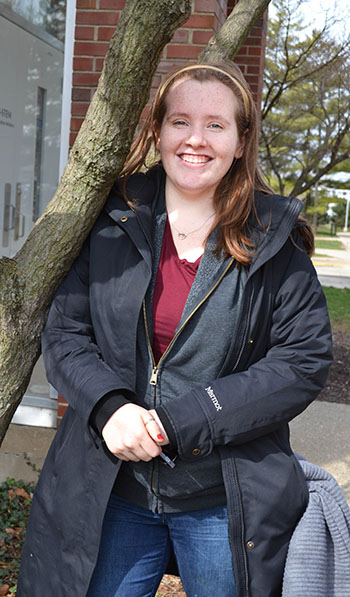
Sara Kochanski, President of Engineering Ambassadors
April 23, 2018
The current president of Engineering Ambassadors (EA), Sara Kochanski, would tell you that through the organization, she’s gained a desire to teach, improved her speaking and leadership skills, acquired self-confidence, and made friends. In fact, she’s loved being an Engineering Ambassador so much that she hopes to do it for the rest of her life (unofficially, of course, and not necessarily on the Illinois campus). She intends to remain an ambassador for engineering and to keep sharing her passion for the field with youngsters day in day out…as a teacher.
“Engineering Ambassadors has turned me into what I am today,” she acknowledges. “I know it's odd for someone in engineering to switch.”
What about the College of Engineering’s EA program caused this turnaround—switching career goals from being an engineer to teaching about it? “We kept going to schools and explaining to kids these difficult concepts,” Kochanski admits, “and I just realized that I loved seeing the light turn on. Like when they did a project, and they'd get so excited because they made a car out of a balloon and cardboard.”
But it’s not just about seeing the light bulb come on. Kochanski craves impacting students the way only a teacher can: “They impact so many different people,” she admits, “and I want to be able to impart that to other people. So many people think they can't do something because one bad teacher told them that they couldn't do it. I just couldn't live with that…”So she plans on becoming a teacher and reversing that trend.
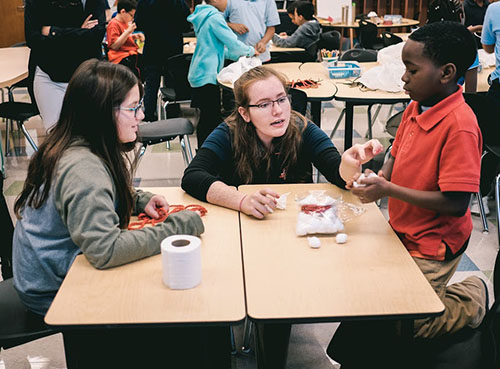
Sara Kochanski (center) works with a student during an EA visit to a local school.
The school visits that so significantly impacted Kochanski’s career choices are one of EA’s main activities. Co-founder and co-advisor, Bioengineering Associate Professor Jenny Amos, calls outreach activities in K–12 schools the group’s “bread and butter.” They usually visit around three different schools a week, depending on what time slots EA students, who juggle outreach with classes and tests, can accommodate. Also, EA does outreach to not just local but regional schools, such as Chicago Public Schools, both hosting big events in Chicago for the community there and hosting CPS events here on campus.
According to Amos, EA’s main mission, both through school outreach and its other activities, is “Changing the conversation on engineering and making it more accessible to the public.”
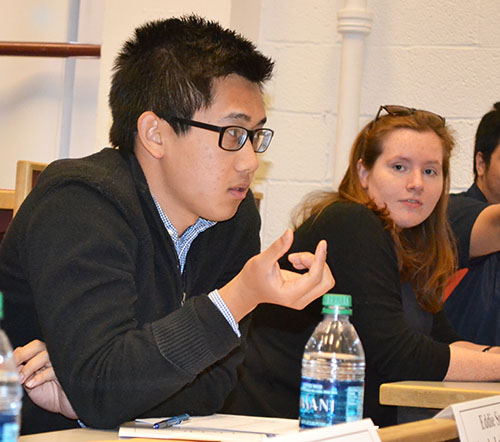
Left to right: Eddie Sun, one of the judges at the recent EA Speaking Competition, and Sara Kochanski, President of EA
In an effort to change the conversation, EA's on-campus activities include its recent Speaking Competition to help STEM students improve their speaking skills, plus helping to host campus events, like Engineering Open House. In addition, because EAs are effective communicators, they often serve as the “Face” of the College for events, such as meeting recruiters for career fairs. Also, a resume review expert from the Review Me program in the Engineering Career Center has trained EA students to teach other students how to write effective resumes. Ambassadors not only train their Engineering peers, but other RSOs sign up to get mentored too. Plus, EA isn't just all work; Kochansk says they hold social events too, like the karaoke night she was going to at a friend’s house.
Of course, part of making engineering more accessible is training students how to present to the public. In fact, Kochanski got her first taste of teaching courtesy of EA's mandatory training, where students learn how to present in Engineering Ambassador's style—Assertion Evidence—which goes something like this.
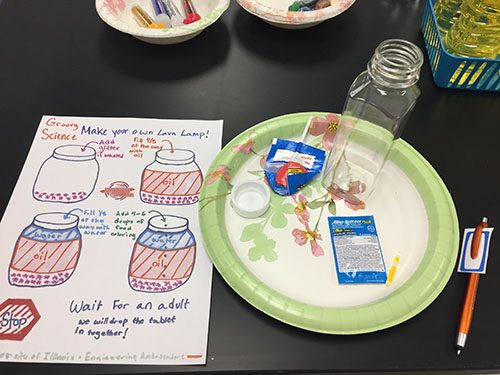
Above: A science experiment the Ambassadors have students do during outreach—making a lava lamp.
Below: Engineering Ambassadors present in a local classroom.
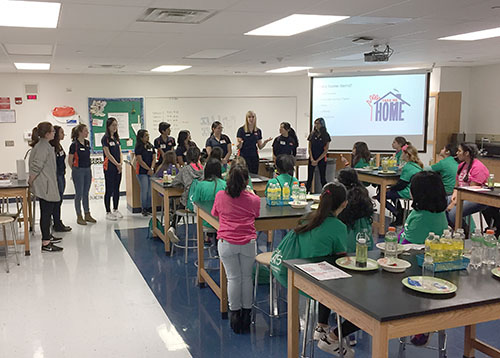
Suppose EA students have a science topic, such as “Chemistry is a building block of society,” that they want to teach. “You show how chemistry is put into buildings,” she explains, “and goes into the food you eat, etc. It's saying something and backing it up.”
Back when Kochanski took the training, it was a 3 day-orientation. But because because EA has grown from four members back in 2012 to 40 in 2017-18, training has morphed into a 6-week class the second half of fall semester, or there's a full-day workshop in the spring for those who can't take the fall class. However, the advisers don't want it to grow too much, lest they lose the group’s quality and sense of community. To ensure that the quality remains, EA leadership is considering implementing a buddy system next semester, so new EA's are mentored by the older ones.
What impact did the training have on Kochanski’s ability to present? It significantly improved her speaking. “I am so bad at talking,” she says. “I talk all the time, but I was so bad at it. I would say ‘um’ and ‘like’...”

EA Advisers Brunet and Amos weild their gavels.
Enter “The Gavels”—all in good fun, but evidently also quite effective. Amos and co-founder and co-adviser Marie-Christine Brunet, Engineering’s Assistant Dean for Undergraduate Programs, somehow got ahold of two brightly colored gavels which they would liberally and loudly bang every time one of the offending filler words would crop up.
“The hammers were the worst when they first came around,” says Kochanski, “Everyone was saying ‘um’ and ‘like.’ It was so horrible trying to break that habit, but no one says it anymore; we barely need them now. I never thought we'd have to do them, but it's hilarious, and it's become a staple!”
What about when EA students need to be admonished for, say, neglecting to fulfill their obligations in a timely fashion? Enter “The PHOTO.”
“That is my favorite picture of all time,” Kochanski admits, referring to a photo of the two advisors frowning. Privy to how the photo came about, she shares this anecdote:

EA Advisers Amos & Brunet in "The Photo."
Last year, an EA leader was complaining to the advisors that Ambassadors were sometimes late to classroom visits. ‘So we need a picture to intimidate them to be on time,” the leader had suggested. So the two posed for “The Photo,” then along with it, sent the message, “If you are late, you're going to have to talk to us!” as a deterrent. And it has evidently been working!
But despite the need for creative interventions periodically, the advisors find watching students grow and mature to be quite rewarding. They note that students who first join the Ambassadors are quite shy, but soon, “We see their level of confidence climbing!” Brunet admits. “And there is something very special about this,” she continues, “When you teach something, you don't see automatically the immediate impact. But with this program, you see the immediate or very-soon-after impact.”
“Massive transformations in our ambassadors,” Amos agrees.
Kochanski agrees too and acknowledges the transformation EA has made in her and others’ lives.
For instance, she shares an anecdote about the impact EA has had on her fellow Ambassadors. “First of all,” she explains, inserting a caveat regarding her tendency to be vocal: “I come from a big family. I have 21 first cousins. If you aren't talking really loud, you're not going to be heard!”
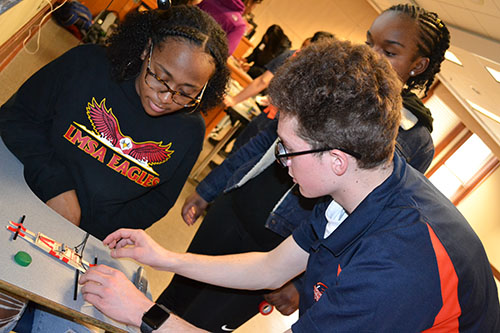
Engineering Ambassador Max Asselmeier (right) works with Chicago Public School students making a Mouse Trap Car during a recent Experience Illinois session on campus.
Then she goes on to describe a less outgoing EA member: “He was so quiet. He came in with me and was the quietest person I've ever met in my life! I can name like 20 people who were so quiet and timid, and then they joined Engineering Ambassadors, and now they're so vibrant and amazing. It's so cool to see the transformation.”
While Kochanski didn't need to overcome timidity, she has gained other benefits from being in EA. “Personally, I wouldn't be who I am without Engineering Ambassadors, she declares. “I'm a lot more secure in what I want to do, and have learned that it doesn't matter what your title is, as long as you're happy. Engineering Ambassadors doesn't just change your résumé, it changes your life. And I mean that in the least corny way possible.”
Regarding her résumé comment, Kochanski admits that EA does look good on one’s résumé. “You want to have something like this on your résumé,” she admits, “but we want people who care too. We don't want people who come just to put this on their résumé. Everyone goes on classroom visits every semester, and I think everyone cares about what we do.”
To safeguard against perennial résumé-builders, applicants undergo a rigorous interview and selection process. Regarding the hoops students must jump through to be a part, Brunet and Amos stress that EA is not a club. “It's a College-sponsored program,” says Amos, “not a registered student organization. It's prestigious. Participants have to take the training, which is a class. They’re interviewed by a panel in order to get into the organization, and there are required participation points. So, it's pretty rigorous,” she adds. “It's not just an organization.”
“I think that's why we are tight,” Brunet continues. “Because we all believe in the same principles and commitment.”
Kochanski would agree that EA’s being a group of like-minded people is what makes it so special. “Everyone in Engineering Ambassadors legitimately cares about kids and what they do, and it's really nice to be with people who have the same priorities you do,” she admits. “You're never going to feel like you're 1 in 40; you will always feel like you're a part of a little family, and you get out of it what you put in.”
And Kochanski has put a lot into the group; she was vice president her junior year and president this past year. She describes her presidential duties:

The next president of EA, Jose De Lara (center) and two other Engineering Ambassadors, expose nine Chicago Public School students to engineering during a recent Experience Illinois session.
“You just have to make sure that people do what they have to do, and if there's a problem you just handle it. You talk to advisers about ideas; you start implementing them at the base level. I've been organizing an outreach for next semester, so when the next person takes over they can just plug and chug and go on.”
Regarding the prestige of being the group’s president, she deprecatingly terms it: “It's just a ‘glorified substitute.’ Whenever someone drops out of a class visit, I have to go!”
But while she’s given a lot to EA, she’s also gotten a lot in return. She tells of a time when she was minoring in ECE and could not figure out a problem in her homework. She had come to EA early still trying to work on it, but just couldn't get it. Then, all the ECE majors came over. “They were helping me figure out the problem,” she says. “And by the end of it, I had the homework done because they were helping me through all the steps and teaching me how to do it. Even Dean Brunet came over to make sure that we did it right…If you ever need help, people will help you.”
In fact, Kochanski and another Aerospace major in EA get together all the time to do homework. “It's not only helping your resume,” she adds, “but it's also helping your GPA.”
Despite all that she’s acquired through EA, for Kochanski, what has impacted her the most is the relationships: “It's a lot of people that you care about, and I have a lot of friends in that group,” she admits. “I love them all, they're all amazing. EA is a place that you feel like you're at home.”
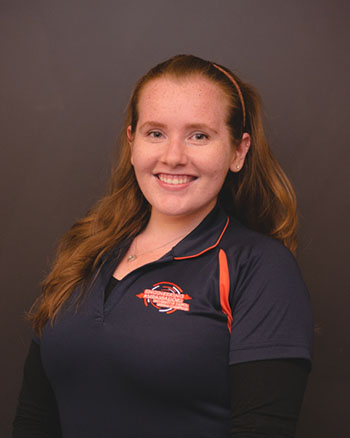
Sara Kochanski, President of Engineering Ambassadors
But even more important are her relationships with the EA advisers: “Dr. Amos and Dean Brunet are the foundation of it, and they're brilliant. I look up to them, and they're one of the reasons why I want to be a teacher. These strong independent women are amazing." Then she adds, “Dr. Amos and Dean Brunet are power houses, I have no idea how they do everything they do. They inspire you to be better and help you to be a better person.”
Like Kochanski, the advisors also find EA to be very rewarding personally. “Engineering Ambassadors is something we both make time for,” Amos admits. “We don't have time for it, but we make time for it. We love it; we get excited to come and interact with our Engineering Ambassadors. It's kind of like a hobby.” “We are very proud of our students,” adds Brunet.
In light of the impact EA has had on her personally, what piece of advice would Kochanski give someone who was considering joining EA? For one, she’d tell them that giving presentations is not as hard as it seems, because the Ambassadors have been well trained.
“Sometimes they'll see the people who have been in EA a long time go up and talk about these topics. And they'll think, ‘I can't do this; it's too much!’ We've been doing this significantly longer than you have. We've been on countless visits; that’s why we can do this.”
Her second piece of advice is to “Just take it slow and remember your training!” And along with that, she would tell them to be confident.
“You just have to embrace yourself and realize that you're more confident. That's basically what EA teaches you, to be more confident.” She says a speaker can’t be a good presenter unless they believe in what they're saying and they believe in themselves. “And that's what we're trying to do: be an effective communicator and also a good presenter.” She thinks that's why a lot of people in EA end up more social and better presenters because EA is teaching them “how to believe in themselves and be more confident.”
Her third piece of advice, “I'd say go to social events, because you'll make amazing friends here!”
Story and photographs by Elizabeth Innes, Communications Specialist, I-STEM Education Initiative.
More: Engineering, 2018
For additional I-STEM web articles about the Engineering Ambassadors, see:

Engineering Scholars (standing) share about an engineering activity with local school children."













.jpg)
















